New Serverless BERT with Huggingface, AWS Lambda, and AWS EFS
4 months ago I wrote the article "Serverless BERT with HuggingFace and AWS Lambda", which demonstrated how to use BERT in a serverless way with AWS Lambda and the Transformers Library from HuggingFace.
In this article, I already predicted that "BERT and its fellow friends RoBERTa, GPT-2, ALBERT, and T5 will drive business and business ideas in the next few years and will change/disrupt business areas like the internet once did."
Since then the usage of BERT in Google Search increased from 10% of English queries to almost 100% of English-based queries. But that's not it. Google powers now over 70 languages with BERT for Google Search.

https://youtu.be/ZL5x3ovujiM?t=484
In this article, we are going to tackle all the drawbacks from my previous article like model load time, and dependency size, and usage.
We are going to build the same "Serverless BERT powered Question-Answering API" as last time. But instead of using compressing techniques to fit our Python dependencies into our AWS Lambda function, we are using a tool called efsync. I built efsync to automatically upload dependencies to an AWS EFS filesystem and then mount them into our AWS Lambda function. This allows us to include our machine learning model into our function without the need to load it from S3.
TL;DR;
We are going to build a serverless Question-Answering API using the Serverless Framework,
AWS Lambda, AWS EFS,
efsync, Terraform, the
transformers Library from HuggingFace, and a mobileBert model from
Google fine-tuned on SQuADv2.
You find the complete code for it in this Github repository.
Serverless Framework
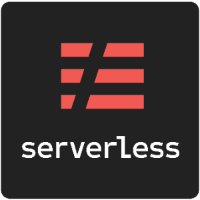
The Serverless Framework helps us develop and deploy AWS Lambda functions. It’s a CLI that offers structure, automation, and best practices right out of the box.
AWS Lambda
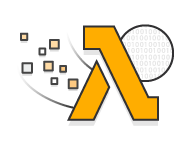
https://aws.amazon.com/de/lambda/features/
AWS Lambda is a serverless computing service that lets you run code without managing servers. It executes your code only when required and scales automatically, from a few requests per day to thousands per second.
Amazon Elastic File System (EFS)
Amazon EFS is a fully-managed service that makes it easy to set up, scale, and cost-optimize file storage in the Amazon Cloud. Since June 2020 you can mount AWS EFS to AWS Lambda functions
Efsync
Efsync is a CLI/SDK tool, which automatically syncs files and dependencies to AWS EFS. It enables you to install dependencies with the AWS Lambda runtime directly into your EFS filesystem and use them in your AWS Lambda function.
Terraform

https://www.terraform.io/logos.html
Terraform is an Infrastructure as Code (IaC) tool for building cloud-native infrastructure safely and efficiently. Terraform enables you to use HCL (HashiCorp Configuration Language) to describe your cloud-native infrastructure.
Transformers Library by Huggingface

The Transformers library provides state-of-the-art machine learning architectures like BERT, GPT-2, RoBERTa, XLM, DistilBert, XLNet, T5 for Natural Language Understanding (NLU) and Natural Language Generation (NLG). It also provides thousands of pre-trained models in 100+ different languages.
The Architecture
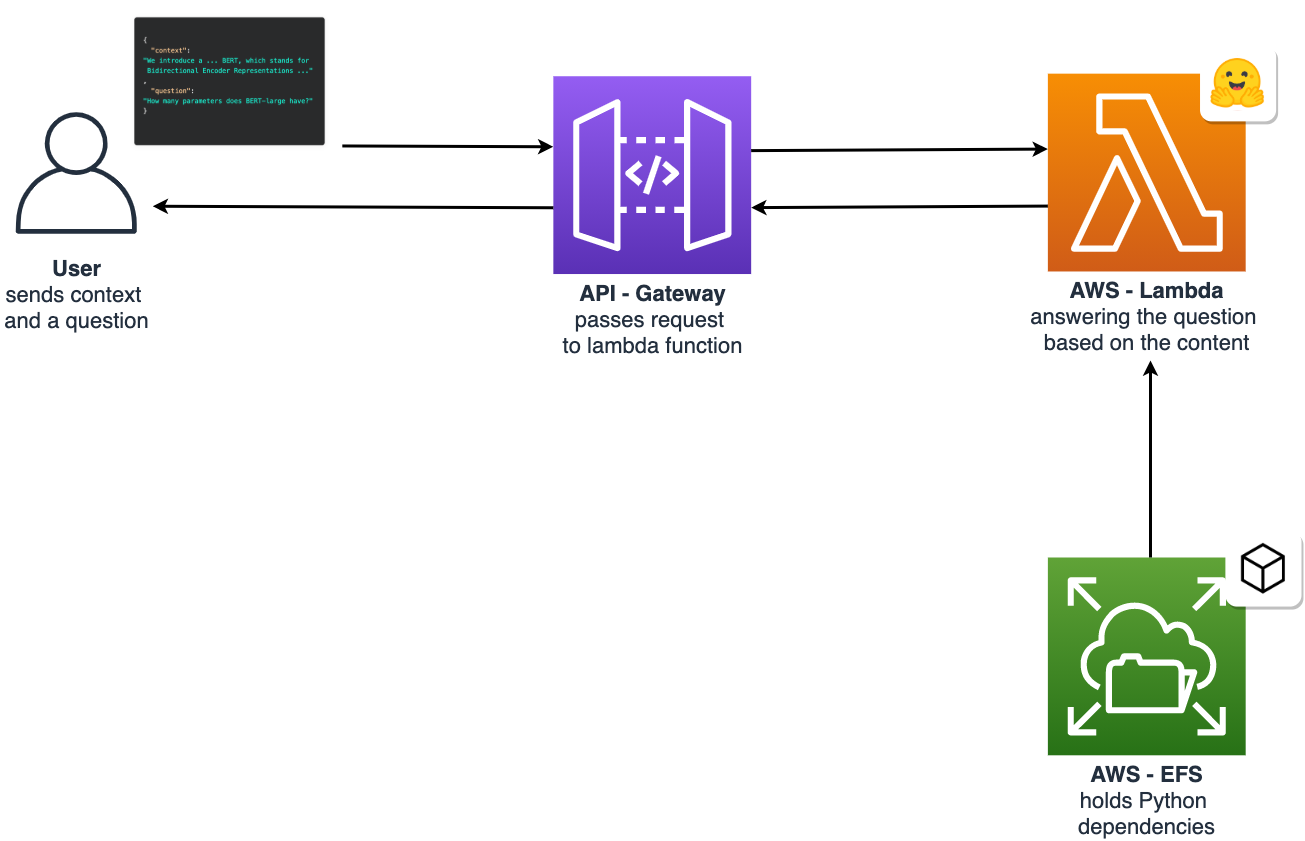
Tutorial
Before we get started, make sure you have the Serverless Framework and Terraform configured and set up. Furthermore, you need access to an AWS Account to create an EFS Filesystem, API Gateway, and the AWS Lambda function.
In the tutorial, we are going to build a Question-Answering API with a pre-trained BERT model from Google.
We are going to send a context (small paragraph) and a question to the lambda function, which will respond with the answer to the question.
What are we going to do:
- create the required infrastructure using
terraform. - use
efsyncto upload our Python dependencies to AWS EFS. - create a Python Lambda function with the Serverless Framework.
- add the
BERTmodel to our function and create an inference pipeline. - Configure the
serverless.yaml, add EFS and set up an API Gateway for inference. - deploy & test the function.
You will need a new IAM user called serverless-bert with AdministratorAccess and configured it with the AWS CLI
using aws configure --profile serverless-bert. This IAM user is used in the complete tutorial. If you don´t know how
to do this check out this link.
Note: I don´t recommend create a IAM User for production usage with AdministratorAccess
Before we start, I want to say that we're not gonna go into detail for every step. If you want to understand more about how to use Deep Learning in AWS Lambda I suggest you check out my other articles:
- Scaling Machine Learning from ZERO to HERO
- How to Set Up a CI/CD Pipeline for AWS Lambda With GitHub Actions and Serverless
- Serverless BERT with HuggingFace and AWS Lambda
- efsync my first open-source MLOps toolkit
You find the complete code in this Github repository.
Create the required infrastructure using terraform
At first, we define and create the required infrastructure using terraform. If you haven´t set it up you can check out this tutorial.
As infrastructure, we need an AWS EFS filesystem, an access point, and a mount target to be able to use it in our AWS Lambda function. We could also create a VPC, but for the purpose of this tutorial, we are going to use the default VPC and his subnets.
Next, we create a directory serverless-bert/, which contains all code for this tutorial with a subfolder terraform/
including our main.tf file.
mkdir serverless-bert serverless-bert/terraform && touch serverless-bert/terraform/main.tfAfterwards, we open the main.tf with our preferred IDE and add the terraform resources. I provided a basic template
for all of them. If you want to customize them or add extra resources check out the
documentation for all possibilities.
# provider
provider "aws" {
region = "eu-central-1"
shared_credentials_file = "~/.aws/credentials"
profile = "serverless-bert"
}
# get all available availability zones
data "aws_vpc" "default" {
default = true
}
data "aws_subnet_ids" "subnets" {
vpc_id = data.aws_vpc.default.id
}
# EFS File System
resource "aws_efs_file_system" "efs" {
creation_token = "serverless-bert"
}
# Access Point
resource "aws_efs_access_point" "access_point" {
file_system_id = aws_efs_file_system.efs.id
}
# Mount Targets
resource "aws_efs_mount_target" "efs_targets" {
for_each = data.aws_subnet_ids.subnets.ids
subnet_id = each.value
file_system_id = aws_efs_file_system.efs.id
}
#
# SSM Parameter for serverless
#
resource "aws_ssm_parameter" "efs_access_point" {
name = "/efs/accessPoint/id"
type = "String"
value = aws_efs_access_point.access_point.id
overwrite = true
}To change the name of EFS you can edit the value creation_token in the aws_efs_filesystem resource. Otherwise, the
name of the EFS will be "serverless-bert". Additionally, we create an SSM parameter for the efs_access_point_id at the
end to use it later in our serverless.yaml.
To use terraform we first run terraform init to initialize our project and provider (AWS). Be aware we have to be in
the terraform/ directory.
terraform initAfterwards, we check our IaC definitions with terraform plan
terraform planWhen this is complete we create our infrastructure with terraform apply
terraform apply
Use efsync to upload our Python dependencies to AWS EFS
The next step is to add and install our dependencies on our AWS EFS filesystem. Therefore we use a tool called efsync.
I created efsync to install dependencies with the AWS Lambda runtime directly
into your EFS filesystem and use them in your AWS Lambda function.
install efsync by running pip3 install efsync
pip3 install efsyncAfter it is installed we create a requirements.txt in our root directory serverless-bert/ and add our dependencies
to it.
https://download.pytorch.org/whl/cpu/torch-1.5.0%2Bcpu-cp38-cp38-linux_x86_64.whl
transformers==3.4.0
Efsync provides different configurations. This time we use the CLI with a
yaml configuration. For that, we create an efsync.yaml file in our root directory.
#standard configuration
efs_filesystem_id: <efs-filesystem-id> # aws efs filesystem id
subnet_Id: <subnet-id-of-mount-target> # subnet of which the efs is running in
ec2_key_name: efsync-asd913fjgq3 # required key name for starting the ec2 instance
clean_efs: all # Defines if the EFS should be cleaned up before. values: `'all'`,`'pip'`,`'file'` uploading
# aws profile configuration
aws_profile: serverless-bert # aws iam profile with required permission configured in .aws/credentials
aws_region: eu-central-1 # the aws region where the efs is running
# pip dependencies configurations
efs_pip_dir: lib # pip directory on ec2
python_version: 3.8 # python version used for installing pip dependencies -> should be used as lambda runtime afterwads
requirements: requirements.txt # path + file to requirements.txt which holds the installable pip dependenciesHere we have to adjust the values of efs_filesystem_id and subnet_Id. Get these values by either looking them up in
the management console or using these two CLI commands.

aws efs describe-file-systems --creation-token serverless-bert --profile serverless-bert
Beware that if you changed the creation_token earlier you have to adjust it here.
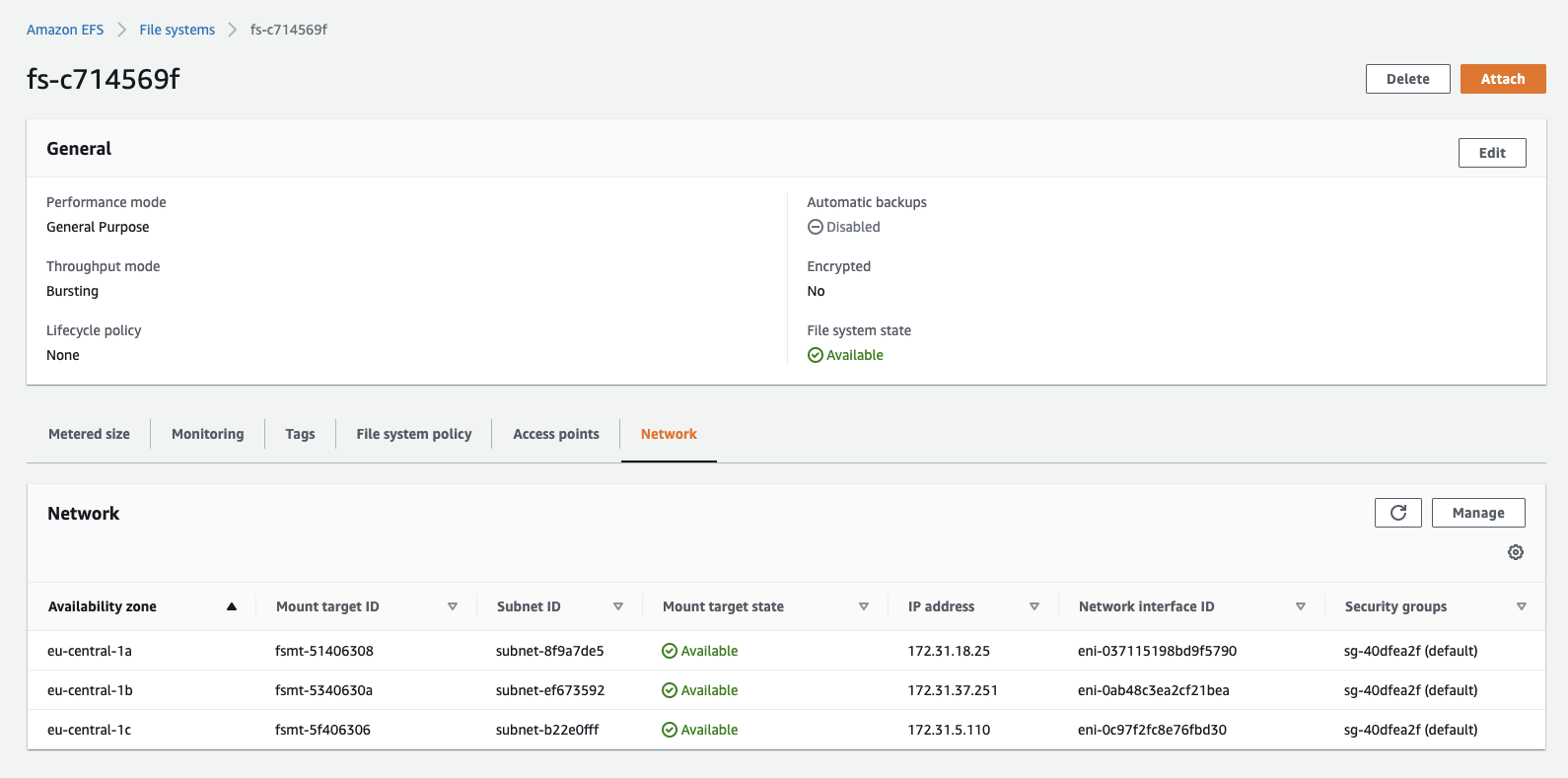
aws efs describe-mount-targets --file-system-id <filesystem-id> --profile serverless-bert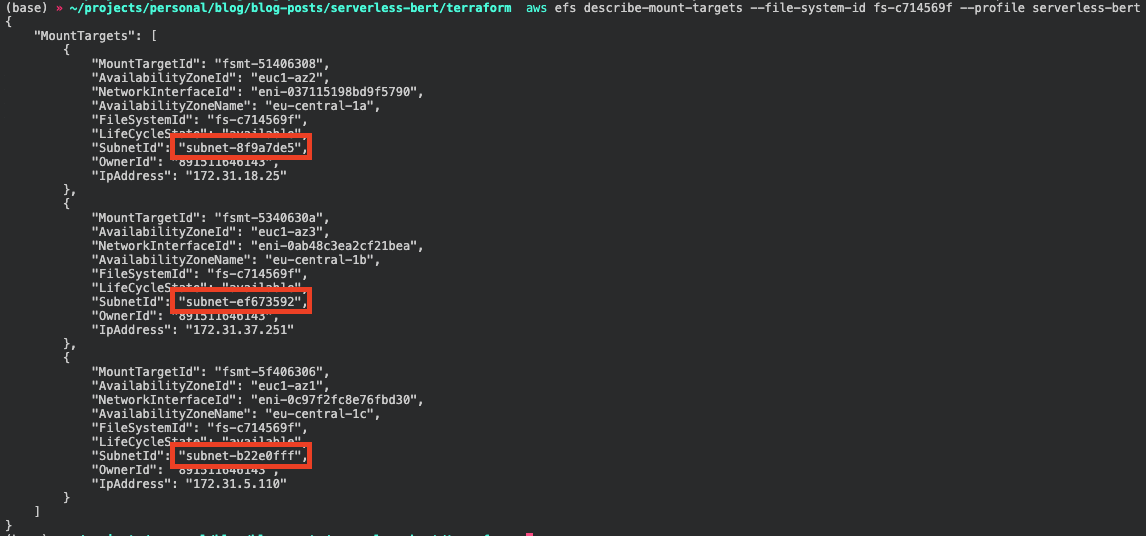
You can choose one of your subnet_Ids for the efsync.yaml configuration. If you want to learn more about the
configuration options, you can read more here.
After the configuration of our efsync.yaml we run efsync -cf efsync.yaml to install our Python dependencies on our
AWS EFS filesystem. This will take around 5-10 Minutes.
efsync -cf efsync.yaml
Create a Python Lambda function with the Serverless Framework
Third, we create our AWS Lambda function by using the Serverless CLI with the aws-python3 template.
serverless create --template aws-python3 --path functionThis CLI command will create a new directory containing a handler.py, .gitignore, and serverless.yaml file. The
handler.py contains some basic boilerplate code.
import json
def hello(event, context):
body = {
"message": "Go Serverless v1.0! Your function executed successfully!",
"input": event
}
response = {
"statusCode": 200,
"body": json.dumps(body)
}
return responseAdd the BERTmodel to our function and create an inference pipeline
Since we are not including our Python dependencies into our AWS Lambda function, we have around 250MB of Storage to use for our model files. For those who are not that familiar with AWS Lambda and its limitations, you can check out this link.
If you want to use models, which are bigger than 250MB you could use efsync to upload them to EFS and then load them from there. Read more here.
To add our BERT model to our function we have to load it from the
model hub of HuggingFace. For this, I have created a python script. Before we can
execute this script we have to install the transformers library to our local environment and create a model
directory in our function/ directory.
mkdir model function/modelpip3 install torch==1.5.0 transformers==3.4.0After we installed transformers we create get_model.py file in the function/ directory and include the script
below.
from transformers import AutoModelForQuestionAnswering, AutoTokenizer
def get_model(model):
"""Loads model from Hugginface model hub"""
try:
model = AutoModelForQuestionAnswering.from_pretrained(model,use_cdn=True)
model.save_pretrained('./model')
except Exception as e:
raise(e)
def get_tokenizer(tokenizer):
"""Loads tokenizer from Hugginface model hub"""
try:
tokenizer = AutoTokenizer.from_pretrained(tokenizer)
tokenizer.save_pretrained('./model')
except Exception as e:
raise(e)
get_model('mrm8488/mobilebert-uncased-finetuned-squadv2')
get_tokenizer('mrm8488/mobilebert-uncased-finetuned-squadv2')To execute the script we run python3 get_model.py in the function/ directory.
python3 get_model.pyTip: add the model directory to gitignore.
The next step is to adjust our handler.py and include our serverless_pipeline().
At first, we add all the required imports and our EFS Filesystem to the PYTHONPATH so we can import our dependencies
from there. Therefore we use sys.path.append(os.environ['EFS_PIP_PATH']). We will define the EFS_PIP_PATH later in
our serverless.yaml.
We create serverless_pipeline() function, which initializes our model and tokenizer and returns a predict function,
we can use in our handler.
import sys
import os
# adds EFS Filesystem to our PYTHONPATH
sys.path.append(os.environ['EFS_PIP_PATH']) # nopep8 # noqa
import json
import torch
from transformers import AutoModelForQuestionAnswering, AutoTokenizer, AutoConfig
def encode(tokenizer, question, context):
"""encodes the question and context with a given tokenizer"""
encoded = tokenizer.encode_plus(question, context)
return encoded["input_ids"], encoded["attention_mask"]
def decode(tokenizer, token):
"""decodes the tokens to the answer with a given tokenizer"""
answer_tokens = tokenizer.convert_ids_to_tokens(
token, skip_special_tokens=True)
return tokenizer.convert_tokens_to_string(answer_tokens)
def serverless_pipeline(model_path='./model'):
"""Initializes the model and tokenzier and returns a predict function that ca be used as pipeline"""
tokenizer = AutoTokenizer.from_pretrained(model_path)
model = AutoModelForQuestionAnswering.from_pretrained(model_path)
def predict(question, context):
"""predicts the answer on an given question and context. Uses encode and decode method from above"""
input_ids, attention_mask = encode(tokenizer,question, context)
start_scores, end_scores = model(torch.tensor(
[input_ids]), attention_mask=torch.tensor([attention_mask]))
ans_tokens = input_ids[torch.argmax(
start_scores): torch.argmax(end_scores)+1]
answer = decode(tokenizer,ans_tokens)
return answer
return predict
# initializes the pipeline
question_answering_pipeline = serverless_pipeline()
def handler(event, context):
try:
# loads the incoming event into a dictonary
body = json.loads(event['body'])
# uses the pipeline to predict the answer
answer = question_answering_pipeline(question=body['question'], context=body['context'])
return {
"statusCode": 200,
"headers": {
'Content-Type': 'application/json',
'Access-Control-Allow-Origin': '*',
"Access-Control-Allow-Credentials": True
},
"body": json.dumps({'answer': answer})
}
except Exception as e:
print(repr(e))
return {
"statusCode": 500,
"headers": {
'Content-Type': 'application/json',
'Access-Control-Allow-Origin': '*',
"Access-Control-Allow-Credentials": True
},
"body": json.dumps({"error": repr(e)})
}Configure the serverless.yaml, add EFS, and set up an API Gateway for inference.
I provide the complete serverless.yamlfor this example, but we go through all the details we need for our
EFS-filesystem and leave out all standard configurations. If you want to learn more about the serverless.yaml, I
suggest you check out
Scaling Machine Learning from ZERO to HERO. In
this article, I went through each configuration and explain the usage of them.
service: new-serverless-bert-lambda
plugins:
- serverless-pseudo-parameters
custom:
efsAccessPoint: ${ssm:/efs/accessPoint/id}
LocalMountPath: /mnt/efs
efs_pip_path: /lib
provider:
name: aws
runtime: python3.8
region: eu-central-1
memorySize: 3008 # optional, in MB, default is 1024
timeout: 60 # optional, in seconds, default is 6
environment: # Service wide environment variables
MNT_DIR: ${self:custom.LocalMountPath}
EFS_PIP_PATH: '${self:custom.LocalMountPath}${self:custom.efs_pip_path}'
iamManagedPolicies:
- arn:aws:iam::aws:policy/AmazonElasticFileSystemClientReadWriteAccess
package:
exclude:
- test/**
- lib/**
- terraform/**
- node_modules/**
- .vscode/**
- .serverless/**
- .pytest_cache/**
- __pychache__/**
functions:
questionanswering:
handler: handler.handler
fileSystemConfig:
localMountPath: ${self:custom.LocalMountPath}
arn: 'arn:aws:elasticfilesystem:${self:provider.region}:#{AWS::AccountId}:access-point/${self:custom.efsAccessPoint}'
vpc:
securityGroupIds:
- <your-default-security-group-id>
subnetIds:
- <your-default-subnet-id>
- <your-default-subnet-id>
- <your-default-subnet-id>
events:
- http:
path: qa
method: postWe need to install the serverless-pseudo-parameters plugin with the following command.
npm install serverless-pseudo-parametersWe use the serverless-pseudo-parameters plugin to get our AWS::AccountID referenced in the serverless.yaml. All
custom needed variables are referenced under custom or in our functions section.
custom:
efsAccessPointshould be the value of your EFS access point. Here we use our SSM parameter created earlier by ourterraformtemplates.LocalMountPathis the path under which EFS is mounted in the AWS Lambda function.efs_pip_pathis the path under which we installed our Python dependencies usingefsync.
functions
-
securityGroupIdscan be any security group in the AWS account. We use thedefaultsecurity group id. This one should look like thissg-1018g448.aws ec2 describe-security-groups --filters Name=description,Values="default VPC security group" --profile serverless-bert -
subnetsIdshould have the same id as the EFS-filesystem. They should look like thissubnet-8f9a7de5.aws efs describe-mount-targets --file-system-id <filesystem-id> --profile serverless-bert
Deploy & Test the function
In order to deploy the function, we run serverless deploy --aws-profile serverless-bert.
serverless deploy --aws-profile serverless-bertAfter this process is done we should see something like this.
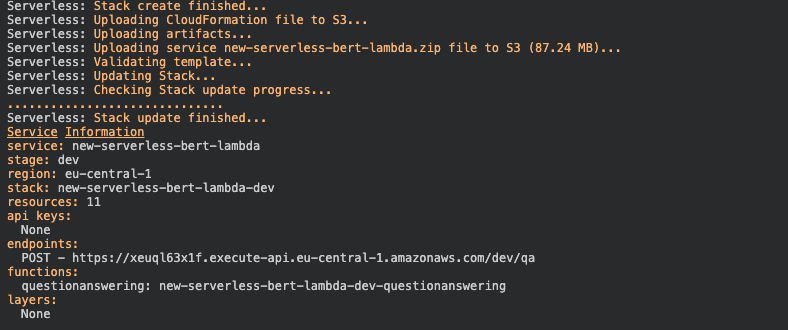
To test our Lambda function we can use Insomnia, Postman, or any other REST client. Just add a JSON with a context and
a question to the body of your request. Let´s try it with our example from the colab notebook.
{
"context": "We introduce a new language representation model called BERT, which stands for idirectional Encoder Representations from Transformers. Unlike recent language epresentation models (Peters et al., 2018a; Radford et al., 2018), BERT is designed to pretrain deep bidirectional representations from unlabeled text by jointly conditioning on both left and right context in all layers. As a result, the pre-trained BERT model can be finetuned with just one additional output layer to create state-of-the-art models for a wide range of tasks, such as question answering and language inference, without substantial taskspecific architecture modifications. BERT is conceptually simple and empirically powerful. It obtains new state-of-the-art results on eleven natural language processing tasks, including pushing the GLUE score to 80.5% (7.7% point absolute improvement), MultiNLI accuracy to 86.7% (4.6% absolute improvement), SQuAD v1.1 question answering Test F1 to 93.2 (1.5 point absolute improvement) and SQuAD v2.0 Test F1 to 83.1 (5.1 point absolute improvement).",
"question": "What is BERTs best score on Squadv2 ?"
}Our serverless_pipeline() answered our question correctly with 83.1. Also, you can see the complete first request
took 2900ms or 29s. 15 seconds of this used to initialize the model in our function.
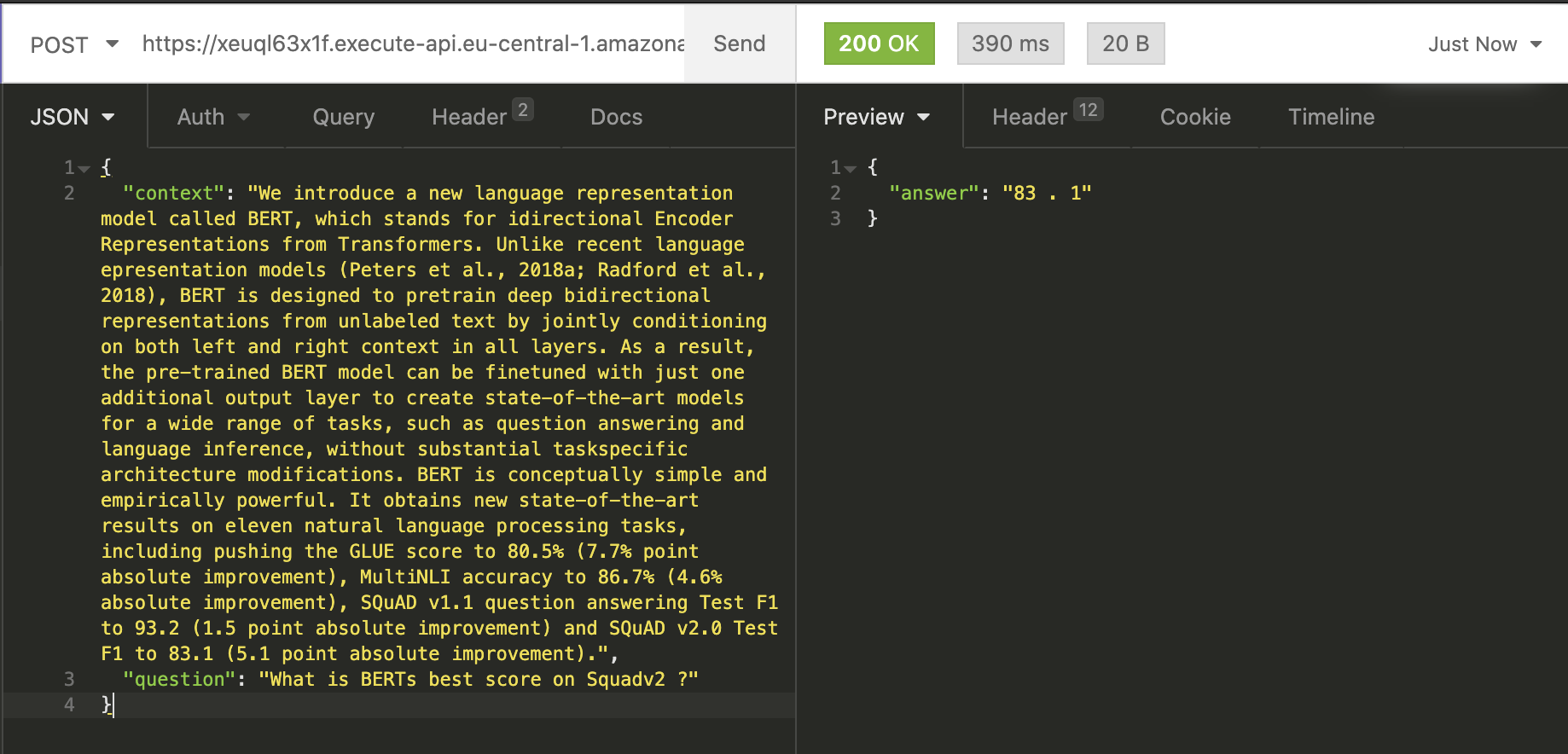
The second request took only 390ms.
The best thing is, our BERT model automatically scales up if there are several incoming requests! It scales up to thousands of parallel requests without any worries.
Conclusion
We have successfully implemented a Serverless Question-Answering API. For Implementation, we used both IaC tools and "State of the Art" NLP models in a serverless fashion. We reduced the complexity from a developer's perspective but included a lot of DevOps/MLOps steps. I think it is necessary to include DevOps/MLOps, which handles your deployment and provisioning if you want to run scalable serverless machine learning in production.
You can find the GitHub repository with the complete code here.
Thanks for reading. If you have any questions, feel free to contact me or comment on this article. You can also connect with me on Twitter or LinkedIn.